Planetary Degrees Prediction by Selva Ganesh
Edited By: Dipesh Parmar
Everyone including the skeptics wonders at one point in their life, what the future holds in store for them. Jyothish, which is the knowledge of relationships based on a study of planetary influences on man and his environment, sheds light on the dark tunnel of future events. It consists mainly of two parts: astronomy (charting of heavenly bodies) and astrology (influence of the heavenly bodies on individuals, society and nature). It is pertinent to note that the astrological chart is based on astronomical data.
This article is a humble, contemporary contribution to the chain of epic studies on this subject in Panchanga Ganitha, Parashar Hora Sastra, Jaimini Sutras, KP system, Bhrigu Nandi Nadi (which mainly depends on planetary combinations in predictive astrology), Planetary Aspects in Western astrology (connected to planetary degrees), Sahams in Tajaka (sensitive points arrived at by a certain calculation of longitudes of various planets) and the works of many others from ancient to medieval times.
These cover the details of Graha Sputa, Graha Sanchara, Dina Gathi, Varga Chakras (event charts relating to some specific point), Bhrigu Bindu (midpoint of Moon and Rahu), Vimshottari Dasha as per the degree of Moon and yogas created by planetary degrees (like Mrithyu Degrees).
Traditional predictive astrology begins with the concept of Navagraha – seven visible planets and two illusionary entities called Rahu and Ketu who have no material existence, and their positions are calculated based on the Earth and the Moon’s transit movements. Rahu and Ketu play a significant role in predictive astrology and have a major role to play in eclipses and related predictions. Planets associated with Rahu-Ketu lose their beneficial karakathwas.
Though the predictive portion of astrology is entirely dependent on the calculation part of it, employing more than one system simultaneously in a scientific manner to convert that data into prediction is an interpretative art. Very few like Tirupur S Gopalakrishnan (GK) have successfully attempted it. Master GK’s degree system, which is the confluence of many methods mentioned above, gives excellent guidance to those who want to master the art of predictive astrology.
1. The highest degree planet and the lowest degree planet in a chart decide the character, energy level, and preferences in the life of a This helps an astrologer to analyze the strength and weaknesses of the native for career counseling. For example, a person with Mercury as the highest degree shines well in marketing, accounting, auditing, trading and gives him plenty of support from his/her friends, etc.
2. Planets in close proximity degree wise (plus or minus 3 degrees orb), irrespective of the Rasi/Bhava they are placed in, act as a planetary combination when giving results. For example, the father of a native who has the Sun and Rahu in similar degrees suffers. A native who has Saturn and Sun within 3 degrees of each other makes wrong financial decisions.
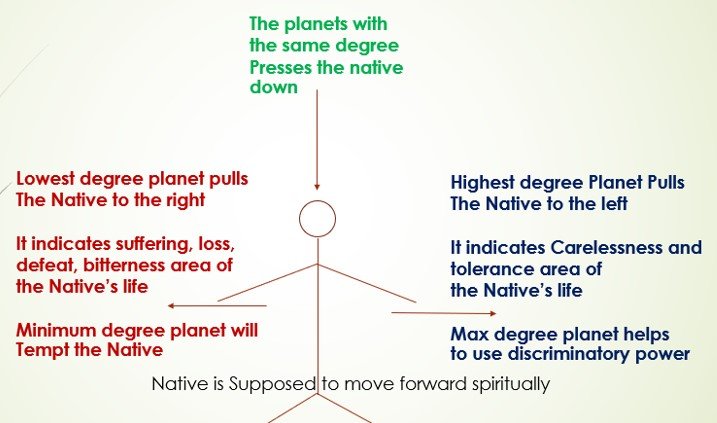
- Superimposing the horoscopes of two or more individuals will act as a planetary conjunction by degrees and give joint effects in a partnership. For example, Saturn’s degree in one chart and Jupiter’s degree in another chart will act as a planetary combination and give good prospects in a professional partnership. Applying this rule to various sets of horoscopes in a team, in an orchestra, or in a partnership, an astrologer can find the common area of strength between two or more individuals, which will help the astrologer to sort out relationship issues.
- Highest and lowest degree planets in their Dasha/Bhukti give health issues.
- Planets that are closer to each other, give health issues when they become Dasha/Bhukti lords themselves. Rules Number 4 and 5 can help an astrologer to decide the timing of an illness plaguing the native.
- Planets caught alone at the midpoint of the Rahu-Ketu axis lose their beneficence, thus losing their ability to confer benefic results as the karakathwas of that planet suffer.
- As per GK’s degree system, the karakathwas of the planets/planetary combinations placed close to Rahu-Ketu’s degrees suffer (+ or – 3 degrees), and those placed near Jupiter’s degrees prosper. The planets conjoining Rahu/Ketu by degree will suffer in terms of their functionality and strength and planets conjoining Jupiter’s degrees will be empowered, giving benefic results.
- The sensitive midpoint between the Moon and Rahu is called Bhrigu Bindu and planets placed close to it or transit planets crossing over it will give an important life event.
- Planets in a natal chart create special combinations with the similar degree planets in transit and act as a combination to give important life events. For example, natal Mars and transit Rahu in close proximity degree-wise will lead to accidents, injuries, weapon attacks, etc. Whereas, transit Jupiter’s degree and natal Saturn’s degree will lead to the fructification of the efforts the native has put in the past.
Example 1
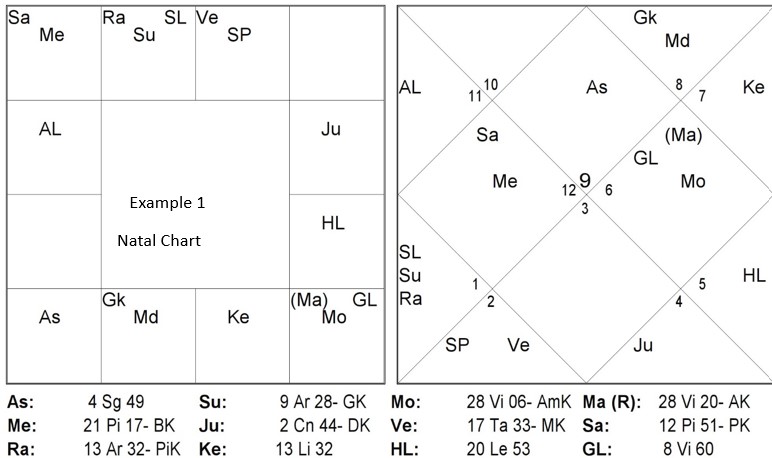
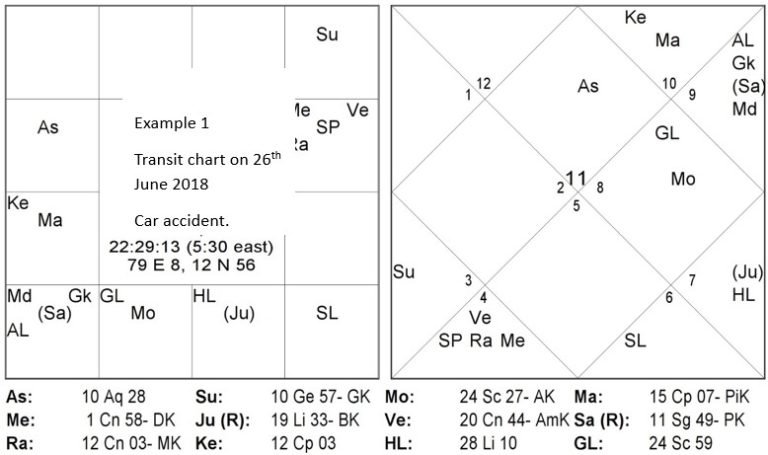
In the example chart given above, Jupiter’s karakathwa is affected at the midpoint of the Rahu-Ketu axis. The native does not have children. The closer the degree, the more the malefic influence. The Sun (also the 9th lord) is positioned close to Rahu-Ketu’s degrees. The native’s father who was running his business successfully suddenly lost everything after the birth of the native. The native had suicidal thoughts when Rahu was transiting close to Jupiter’s degrees in the year 2000.
Planets placed in degree-wise proximity in a natal chart act as a planetary combination. In the example chart given above Mars and Moon are in close proximity degree wise. As per Nadi rules, the combination will incline the native towards alcohol addiction.
Natal Chart vs Transit chart
In the month of June 2018, transit Mars, Saturn and Rahu were near the natal Rahu and Saturn’s degrees. As a consequence, the native met with a car accident. Here Saturn, Rahu, or Ketu were not even transiting over natal Mars in the same sign. But they were all in nearby degrees in different signs (the western concept of planetary aspects at 30, 60, 90, 120, 150-degree intervals and the rules of GK’s degree system worked very well in this example).
Some more example charts of natives who had car accidents are given below:
Example 2
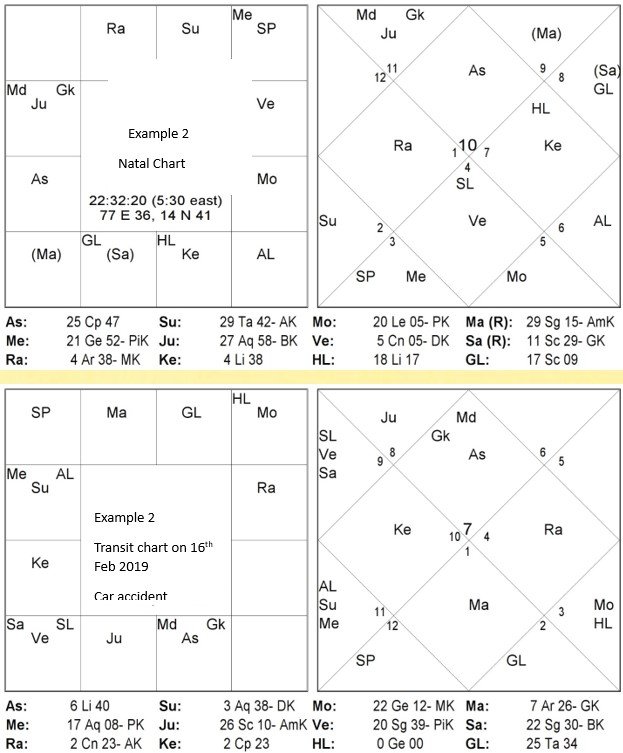
Example 3
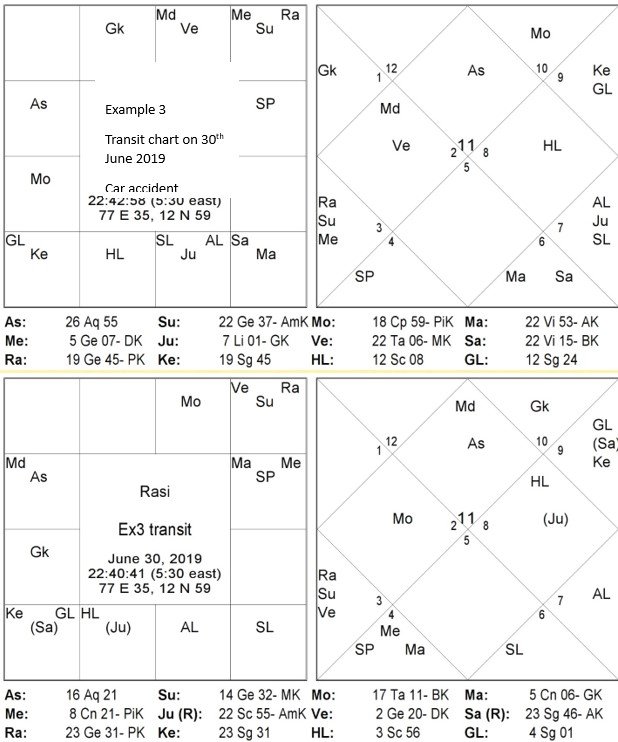
The highest degree planet and the lowest degree planet
The highest-degree planet and the lowest-degree planet in a chart play an important role in the native’s life with respect to their karakathwas. In the example chart No.1, Jupiter being at the lowest degree, made the native long for children. Jupiter’s influence made him a good teacher, while the highest degree planet, Mars made him a good civil engineer.
Examples 3 and 4
| Sun | 1 Vi 04’ | Sun | 29 Cn 06’ | |
| Moon | 15 Sc 41’ | Moon | 20 Ar 20’ | |
| Mars | 1 Sc 16’ | Mars | 12 Cn 47’ | |
| Mercury (R) | 0 Vi 17’ | Mercury | 7 Le 05’ | |
| Jupiter (R) | 6 Aq 33’ | Jupiter | 17 Le 41’ | |
| Venus | 16 Le 18’ | Venus | 14 Le 28’ | |
| Saturn | 29 Le 44’ | Saturn (R) | 2 Ar 05’ | |
| Rahu | 5 Pi 12’ | Rahu | 18 Pi 33’ | |
| Ketu | 5 Vi 12’ | Ketu | 18 Vi 33’ | |
| Maandi | 8 Ta 13’ | Maandi | 24 Vi 20’ |
| Arvind Kejriwal |
| Narendra Modi |
The Sun is at the lowest degree in Narendra Modi’s chart on the left and at the highest in Arvind Kejriwal’s chart on the right, influencing them both to be in politics, administration, and power struggles. Saturn at the highest degree in Modi’s chart made him work harder.
The joint effect of 2 or more horoscopes
The combined effect of two or more horoscopes decides the success or failure of the relationship.
The lowest degree planet should not be the birth star of the spouse. In the examples below, the natives struggled because their birth star was of the lowest degree planet of the spouse.
Examples 5 and 6
| HusbandJup lowest degree | Ju 3° | Wife Punarvasu Nakshatra | Mo 3° | |||||
| Ra 4° | Mo 12° | |||||||
| WifeRa lowest degree | Husband Aridra Nakshatra | |||||||
| Ma 24° | Ke 4° | Ve 13° | ||||||
Planetary combinations in transit charts and world events
Example 7
| Md 6 | Ke 5 | Mo 17 | Ju 16 |
| Su 23 | 8 March 2014MH 370 went missing | ||
| Me 26, Ve 7 | |||
| (Ma) 3, (Sa) 29, Ra 5 | |||
Mars and Rahu in close degrees along with Mandi
- Above planets in Libra – an air sign – signifying the airborne event
Example 8
| Mo 27, Sa 20 | Ju 17, Ra 9 | ||
| 11 September 2001 Twin Tower attack | Ve 23 | ||
| Su 24 | |||
| Ma 7, Ke 9, Md 8 | Me 19 | ||
Mars, Ketu and Mandi close in degrees
- Sagittarius signifying the fiery event
Example 9
| Ke 16 | 8th November 2016 Demonetisation | ||
| Ma 5, Mo 24 | Ra 16 | ||
| Ve 0 | Sa 21 | Su 21, Me 28 | Ju 18 |
Venus, the significator of liquid cash, is at the lowest degree.
- Jupiter, the significator of cash on a higher level, is closer to Rahu/Ketu degrees.
- The Sun and Saturn being at close degrees led to bad financial decisions (gamblers who lose everything overnight often have this combination).
- Mercury, the significator for banks is at the highest degree and banks acquired strength on that day.
More than 4 or 5 planetary degrees in the natal chart when getting repeated in transit give rise to important and defining life events.
The late Shri Rajiv Gandhi’s chart is given below as an example to explain the same.
Example 10
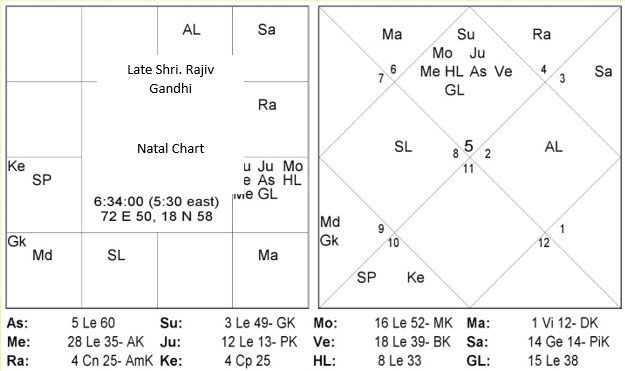
| Lagna | 12 Li 51’ | Lagna | 21 Ta 08’ | |
| Sun | 14 Li 10’ | Sun | 5 Ta 47’ | |
| Moon | 8 Cp 21’ | Moon | 8 Le 32’ | |
| Mars | 24 Sg 44’ | Mars | 3 Cn 05’ | |
| Mercury | 26 Li 43’ | Mercury | 11 Ar 26’ | |
| Jupiter | 15 Sg 03’ | Jupiter | 13 Cn 39’ | |
| Venus | 19 Sc 30’ | Venus | 19 Ge 29’ | |
| Saturn | 24 Li 06’ | Saturn | 13 Cp 06’ | |
| Rahu | 4 Ta 48’ | Rahu | 27 Sg 59’ | |
| Ketu | 4 Sc 48’ | Ketu | 27 Ge 59’ | |
| Mandi | 28 Ar 34’ | Mandi | 18 Le 57’ |
| Degrees of Planets on the day he was declared as PM. |
| Degrees of Planets on the day he was assassinated. |
Even an event like becoming PM, on a day when transits coincide with the degrees of many planets in the natal chart can lead to a malefic event in the future.
Mrithyu Degree
Planets placed near Mandi’s degree or the Mrithyu degrees can become malefic in one of their karakathwas. In some cases, they act as marakas as well.
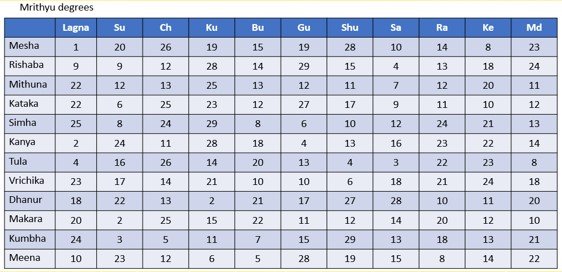
Example 11
| Lagna 4 | Moon 28, Mars 28 | ||
In this chart Mars is placed near the Mrithyu degree and is also placed near the Ashtama (8th) Lord. Thus, indicating that the native is prone to injuries while traveling.
This article is written with examples, personal observations and experience ranging from personal horoscopes, celebrity horoscopes, mundane astrology, and horoscopes of business organizations. The author is positive that the content presented in the article will be of value to research scholars in Jyothish, aiding them in further honing their craft of predictive astrology.
Om Tat Sat


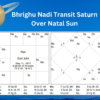

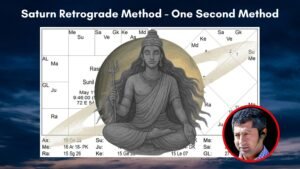
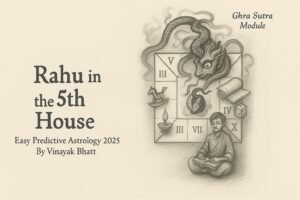
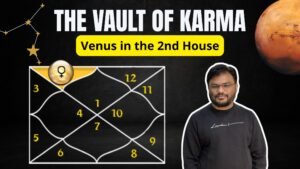
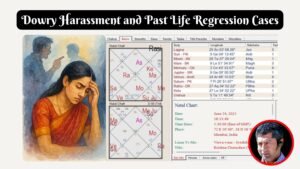
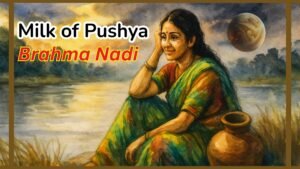
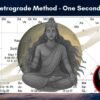
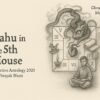


Leave a reply
You must be logged in to post a comment.